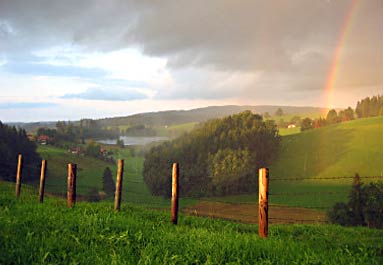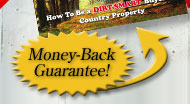This original column is provided free for one-time use with author credit at the end. It may be used for background with author credit. Copyright applies.
#73 FOR IMMEDIATE RELEASE: February 12, 2009
You need a farm truck on your farm team
By Curtis Seltzer
BLUE GRASS, Va.—I don’t romanticize farm trucks. Mine doesn’t get Christmas presents like some do. And it’s not allowed up on my bed, even with clean feet.
A farm truck never washes or changes its socks. It’s comfortable being a bachelor.
I consider my 1980 4WD Toyota pickup with 260,000 miles a full-time farm laborer who has to earn his keep. He is known as “The Cheetah,” because a scrap of factory-yellow paint is still visible on his rusty hood, between the open portholes.
In his prime, a solid 30 mph was within his reach. Today, I don’t push him much beyond the low elevens.
The Cheetah has been adapted for farm and woods work. Our local genius welder, Steve Good, fabricated a roll bar that he attached to those parts of the truck’s frame that were still visible to the naked eye. To the roll bar he welded old horseshoes to form a tool rack, along with an extension over the cab that holds the spare tire as if by magic. The Cheetah’s belly is held up by a steel corset welded to whatever metal happened to still be in the area.
The Cheetah prefers to move at less than a snail’s pace, growling along in 4WD.
Several months ago, The Cheetah challenged a low-slung, 2008 BMW Z4 Roadster to a one-mile time trial. The Z4 has a herd of about 300 stallions stuffed into its power plant. They are fed three tons of gasified organic oats a minute through either 17 or 18 newly designed “green” carburetors. It goes from zero to 300 mph in one second.
The Roadster’s owner also had a few too many gas-and-air mixer-uppers under his hood. When I ran into him outside a restaurant, he was running full Hallelujah on low-octane fuel out of pop-top cans. He said he was involved in the “gaming industry,” and I assumed from his reluctance to provide details that he ran a TARP bank.
So I put $1,000 even up on The Cheetah…with me picking the course. Mr. Roadster knew he could beat a Ferrari going backward. He’d never heard of a Cheetah, but he figured he’d win without leaving third gear.
Mr. Roadster nearly laughed himself into oxygen depletion when I coaxed the challenger out of the barn, a sprig of hay hanging field-like from his side mirror.
Suddenly, Mr. Roadster accused me of hiding a “sucker engine” under the hood. To demonstrate my integrity, I said he didn’t have to show me his, but I’d show him mine.
With that, I lifted The Cheetah’s hood, taking care to prevent the rusted sheet metal from rupturing under the unfamiliar strain. There, as expected, were its four humble cylinders, most of whom, I said, rarely chose to have much to do with each other. I then put my $1,000 bill on the radiator cap, hoping that its weight wouldn’t blow out the engine mounts.
Mr. Roadster’s slightly less lubricated second finally had a thought. “Where’s the track?” “Up there,” I said, pointing into the woods. I figured the Z4 was good for at least 50 yards before my logging road would spring every horse in its stable.
They left, muttering about yokels trying to “slick urban innocents out of their hard-earned taxpayer bailout money.”
Farm trucks, which are often renamed FARM USE to exempt them from inspection and tags, haul stuff around the farm—firewood, materials, hay, rocks, salt blocks, dogs, manure, children, grown-up children (in both senses), chainsaws and miscellaneous personnel, like unworthy suitors for your daughter.
FARM USE is always painted on, by hand or can. Professional lettering is social climbing.
In the almost 25 years of our relationship, The Cheetah has never rolled me over, gotten stuck, stopped climbing a hill half way up or not gotten a load home. Nothing fancy in this performance, just consistent effort.
I should mention one bad habit—he casts off apparently less-than-essential parts from time to time, and once, in a snit, threw a front wheel into a ditch. I don’t read too much into this unpredictable disrobing. I don’t think it’s psychological like exhibitionism, though I admit he has many screws loose, which probably does have something to do with it.
The Cheetah has refused to open both his doors twice with me inside. I interpreted this as a sign of affection though Pat, the mechanic, said it was just dirt clogging the gears. A video of me wiggling through the window would have made the network news.
Every FU pickup needs a complete set of tools and junk stored at all times on the floor on the passenger’s side. A proper pile should reach the dash.
Long tools tend to hide behind the seat where they carry on with cans of brake fluid.
The FU truck’s dashboard is properly understood as the evolutionary ancestor of the software recycle bin. All unwanted bits of old farm jobs are stored there for instant retrieval.
The most complete dashboard I ever saw was stacked five layers high with profoundly unusable nuts and bolts that lapped like beach surf around parts--broken, paralyzed or spent. Here and there were old plugs that had lost their spark, new parts that hadn’t fit, sockets that had never been put back, sockets that had been purchased to replace the ones that had never been put back, spent shell casings and a ‘68 Nixon campaign button with Agnew shot out.
The final essential element in a farm truck’s bed is loose stuff, which has nowhere to go and gets in the way. Spare tires, for example, or tenured professors of linguistics out for a visit.
Truck manufacturers store spare tires under the bed, secured by a chain that rusts in place no later than your first oil change. Once embedded, the spare must be excavated with an acetylene cutting torch and the Jaws of Life.
Most farm-truck owners solve this problem by throwing the spare into the bed immediately upon purchase. There, however, it is promptly borrowed by someone whose own spare has become petrified in its original position.
If your spare has not been borrowed, you must do something with it every time you need the space in your bed. So you put it in the barn and run bare butt, which brings every nail on every secondary road in a 30-mile radius upright on high alert. It is a rule of country life that you will get a flat every time you “barn your spare.”
A farm truck is properly seen as a member of your team—neither family nor pet. You expect it to do what it’s capable of doing, and occasionally, you ask a little more.
It’s not a hot rod or trailer queen, just a fellow worker.
The neighbor who sold me my farm truck offered this advice: “Never blame The Cheetah for your own stupidity.”
This leaves only my wife available who, like The Cheetah, has been known to throw a shoe at authority even before it became popular at press conferences.
Contact: Curtis Seltzer, Ph.D.
Land Consultant
1467 Wimer Mountain Road
Blue Grass, VA 24413-2307
540-474-3297
curtisseltzer@htcnet.org
www.curtis-seltzer.com
This original column is provided free for one-time use with author credit at the end. It may be used for background with author credit. Copyright applies.
|









